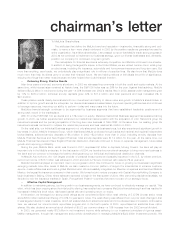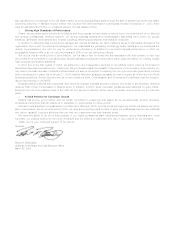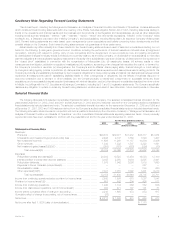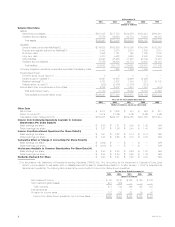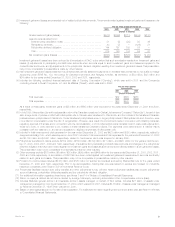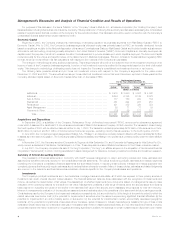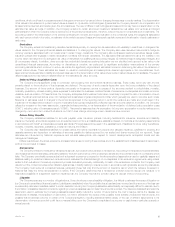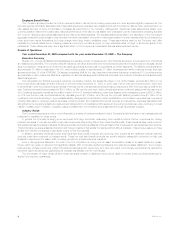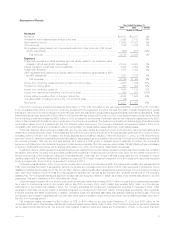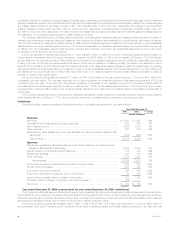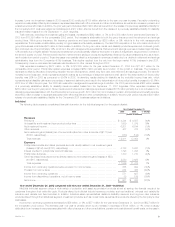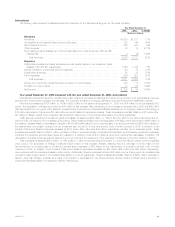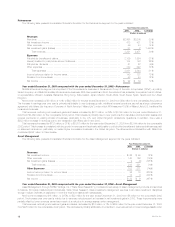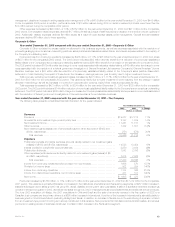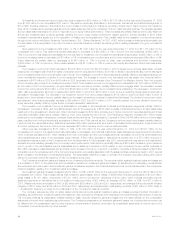MetLife 2003 Annual Report Download - page 8
Download and view the complete annual report
Please find page 8 of the 2003 MetLife annual report below. You can navigate through the pages in the report by either clicking on the pages listed below, or by using the keyword search tool below to find specific information within the annual report.conditions, which could result in prepayments and changes in amounts to be earned due to changing interest rates or equity markets. The determination
of fair values in the absence of quoted market values is based on: (i) valuation methodologies; (ii) securities the Company deems to be comparable; and
(iii) assumptions deemed appropriate given the circumstances. The use of different methodologies and assumptions may have a material effect on the
estimated fair value amounts. In addition, the Company enters into certain structured investment transactions, real estate joint ventures and limited
partnerships for which the Company may be deemed to be the primary beneficiary and, therefore, may be required to consolidate such investments. The
accounting rules for the determination of the primary beneficiary are complex and require evaluation of the contractual rights and obligations associated
with each party involved in the entity, an estimate of the entity’s expected losses and expected residual returns and the allocation of such estimates to
each party.
Derivatives
The Company enters into freestanding derivative transactions primarily to manage the risk associated with variability in cash flows or changes in fair
values related to the Company’s financial assets and liabilities or to changing fair values. The Company also uses derivative instruments to hedge its
currency exposure associated with net investments in certain foreign operations. The Company also purchases investment securities, issues certain
insurance policies and engages in certain reinsurance contracts that embed derivatives. The associated financial statement risk is the volatility in net
income which can result from (i) changes in fair value of derivatives not qualifying as accounting hedges; (ii) ineffectiveness of designated hedges; and
(iii) counterparty default. In addition, there is a risk that embedded derivatives requiring bifurcation are not identified and reported at fair value in the
consolidated financial statements. Accounting for derivatives is complex, as evidenced by significant authoritative interpretations of the primary
accounting standards which continue to evolve, as well as the significant judgments and estimates involved in determining fair value in the absence of
quoted market values. These estimates are based on valuation methodologies and assumptions deemed appropriate in the circumstances. Such
assumptions include estimated volatility and interest rates used in the determination of fair value where quoted market values are not available. The use of
different assumptions may have a material effect on the estimated fair value amounts.
Deferred Policy Acquisition Costs
The Company incurs significant costs in connection with acquiring new and renewal insurance business. These costs, which vary with and are
primarily related to the production of that business, are deferred. The recovery of such costs is dependent upon the future profitability of the related
business. The amount of future profit is dependent principally on investment returns in excess of the amounts credited to policyholders, mortality,
morbidity, persistency, interest crediting rates, expenses to administer the business, creditworthiness of reinsurance counterparties and certain economic
variables, such as inflation. Of these factors, the Company anticipates that investment returns are most likely to impact the rate of amortization of such
costs. The aforementioned factors enter into management’s estimates of gross margins and profits, which generally are used to amortize such costs.
Revisions to estimates result in changes to the amounts expensed in the reporting period in which the revisions are made and could result in the
impairment of the asset and a charge to income if estimated future gross margins and profits are less than amounts deferred. In addition, the Company
utilizes the reversion to the mean assumption, a standard industry practice, in its determination of the amortization of deferred policy acquisition costs
(‘‘DAC’’), including value of business acquired (‘‘VOBA’’). This practice assumes that the expectation for long-term appreciation in equity markets is not
changed by minor short-term market fluctuations, but that it does change when large interim deviations have occurred.
Future Policy Benefits
The Company establishes liabilities for amounts payable under insurance policies, including traditional life insurance, annuities and disability
insurance. Generally, amounts are payable over an extended period of time and liabilities are established based on methods and underlying assumptions
in accordance with GAAP and applicable actuarial standards. Principal assumptions used in the establishment of liabilities for future policy benefits are
mortality, morbidity, expenses, persistency, investment returns and inflation.
The Company also establishes liabilities for unpaid claims and claims expenses for property and casualty insurance. Liabilities for property and
casualty insurance are dependent on estimates of amounts payable for claims reported but not settled and claims incurred but not reported. These
estimates are influenced by historical experience and actuarial assumptions with respect to current developments, anticipated trends and risk
management strategies.
Differences between the actual experience and assumptions used in pricing these policies and in the establishment of liabilities result in variances in
profit and could result in losses.
Reinsurance
The Company enters into reinsurance transactions as both a provider and a purchaser of reinsurance. Accounting for reinsurance requires extensive
use of assumptions and estimates, particularly related to the future performance of the underlying business and the potential impact of counterparty credit
risks. The Company periodically reviews actual and anticipated experience compared to the aforementioned assumptions used to establish assets and
liabilities relating to ceded and assumed reinsurance and evaluates the financial strength of counterparties to its reinsurance agreements using criteria
similar to that evaluated in the security impairment process discussed previously. Additionally, for each of its reinsurance contracts, the Company must
determine if the contract provides indemnification against loss or liability relating to insurance risk, in accordance with applicable accounting standards.
The Company must review all contractual features, particularly those that may limit the amount of insurance risk to which the reinsurer is subject or
features that delay the timely reimbursement of claims. If the Company determines that a reinsurance contract does not expose the reinsurer to a
reasonable possibility of a significant loss from insurance risk, the Company records the contract using the deposit method of accounting.
Litigation
The Company is a party to a number of legal actions. Given the inherent unpredictability of litigation, it is difficult to estimate the impact of litigation on
the Company’s consolidated financial position. Liabilities are established when it is probable that a loss has been incurred and the amount of the loss can
be reasonably estimated. Liabilities related to certain lawsuits, including the Company’s asbestos-related liability, are especially difficult to estimate due to
the limitation of available data and uncertainty regarding numerous variables used to determine amounts recorded. The data and variables that impact the
assumption used to estimate the Company’s asbestos-related liability include the number of future claims, the cost to resolve claims, the disease mix
and severity of disease, the jurisdiction of claims filed, tort reform efforts and the impact of any possible future adverse verdicts and their amounts. It is
possible that an adverse outcome in certain of the Company’s litigation, including asbestos-related cases, or the use of different assumptions in the
determination of amounts recorded could have a material effect upon the Company’s consolidated net income or cash flows in particular quarterly or
annual periods.
MetLife, Inc. 5


